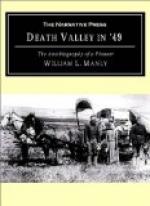Reading people of to-day, who know so well the geography of the American continent, may need to stop and think that in 1849 the whole region west of the Missouri River was very little known, the only men venturesome enough to dare to travel over it were hunters and trappers who, by a wild life had been used to all the privations of such a journey, and shrewd as the Indians themselves in the mysterious ways of the trail and the chase. Even these fellows had only investigated certain portions best suited to their purpose.
The Indians here have the reputation of being blood thirsty savages who took delight in murder and torture, but here, in the very midst of this wild and desolate country we found a Chief and his tribe, Walker and his followers who were as humane and kind to white people as could be expected of any one. I have often wondered at the knowledge of this man respecting the country, of which he was able to make us a good map in the sand, point out to us the impassable canon, locate the hostile indians, and many points which were not accurately known by our own explorers for many years afterward. He undoubtedly saved our little band from a watery grave, for without his advice we had gone on and on, far into the great Colorado canon, from which escape would have been impossible and securing food another impossibility, while destruction by hostile indians was among the strong probabilities of the case. So in a threefold way I have for these more than forty years credited the lives of myself and comrades to the thoughtful interest and humane consideration of old Chief Walker.
In another pool or pond near the one where we were camped I shot a small duck. Big sage was plenty here for fuel and we had duck for supper. Our party consisted of five men and two small ponies only two years old, with a stock of provisions very small including that the old chief had given us. We started on in the morning, following our faint trail till we came to the canon we had in view, and up this we turned as we had been directed, finding in the bottom a little running stream. Timber began to appear as we ascended, and grass also. There were signs of deer and grouse but we had no time to stop to hunt, for I had the only gun and while I hunted the others must lie idly by. We reached the summit at a low pass, and just above, on the north side of the higher mountains were considerable banks of snow. Following the Chief’s instructions we left the trail and followed some horse tracks over rolling hills, high on the mountain side. We found the Indian camp exactly as the Chief had described, consisting of two or three lodges. The men were all absent hunting, but the women were gathering and baking some sort of a root which looked like a carrot. They made a pile of several bushels and covered it with earth, then made a fire, treating the pile some as a charcoal burner does his pit of coal. When sufficiently cooked they beat them up and made the




